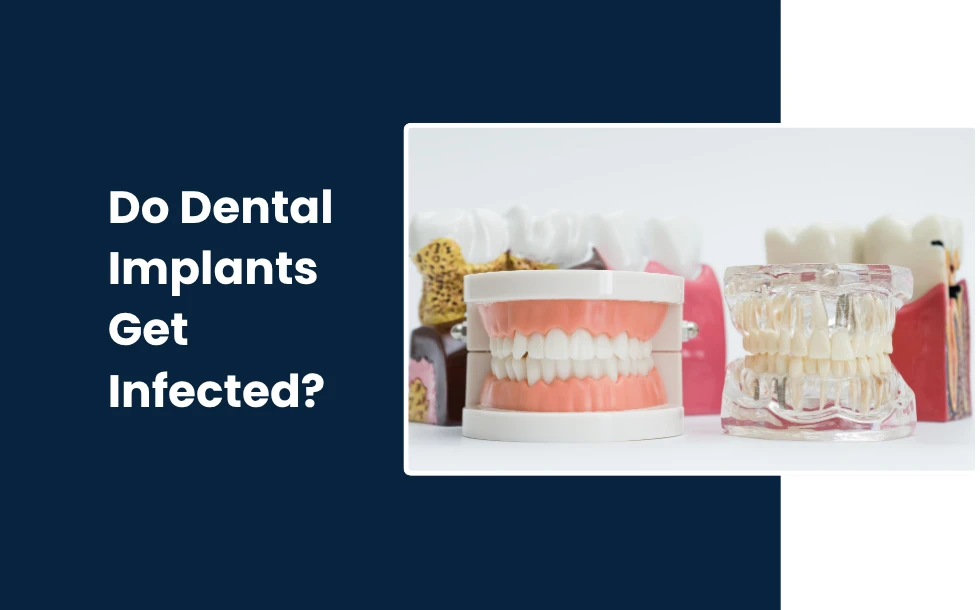Dental implants are designed to be stable and long lasting, but they can still develop infection when the surrounding tissues become irritated or contaminated. In many cases it begins as mild gum inflammation, and if ignored, it can progress to bone loss and treatment failure.
This guide explains the causes, symptoms, treatment methods, and prevention steps. If you are planning this treatment, understanding these points helps support long-term oral health and keeps your implant stable.
What Causes Dental Implant Infection?
One of the biggest concerns after the procedure is a bacterial or gum infection around a dental implant. It usually develops when oral care is neglected, which allows plaque to build up and irritate the surrounding tissues. This early stage is known as peri-implant mucositis.
If it is not managed in time, it can progress to peri-implantitis, which involves redness, swelling, discomfort, and bone loss. Other contributing factors include a loose implant screw, poor osseointegration, or instability around the implant.
A sinus-related issue after an upper-jaw implant can also add to complications. Conditions such as uncontrolled diabetes, smoking, and teeth grinding raise the chance of contamination and slow healing. Following a consistent oral hygiene routine and regular dental visits lowers these risks.
Symptoms of an Infected Dental Implant
Many individuals ask how they would know if an implant is infected. Certain warning signs indicate the need for a dental checkup. These include swollen gums, bleeding, pus, a bad taste, and gum recession around the implant.
It may start as mild gum pain, but more serious symptoms like implant mobility require urgent care to protect the bone and the restoration. Infection around a dental implant is not uncommon, and noticing these symptoms early supports better recovery.

How Dentists Diagnose Implant Infection
Dentists use a combination of clinical checks and imaging to confirm whether an implant is infected. They begin by examining the gums for redness, swelling, or bleeding, since these changes show inflammation around the implant.
Probing around the implant helps measure pocket depth. Healthy tissues stay tight, while deeper pockets often suggest mucositis or peri-implantitis. Your dentist also evaluates mobility to check if the bone is still supporting the implant properly.
X rays play a major role. They reveal early bone loss, changes in the implant’s support, or areas of trapped bacteria that are not visible during the exam. This combination of visual assessment, probing, mobility testing, and radiographs allows the dentist to identify the stage of infection and plan proper treatment.
How Serious Is a Dental Implant Infection?
A dental implant infection should never be ignored because it can progress faster than natural gum disease. Early inflammation affects only the soft tissue, but once bacteria reach the bone, the stability of the implant becomes compromised.
If the infection continues without treatment, it can weaken the bone and lead to implant loosening. In advanced cases, the restoration cannot be saved. Severe infections may also affect nearby teeth or spread within the surrounding tissues.
The seriousness of the condition depends on how early it is detected. Early care generally protects the implant, while delayed treatment increases the risk of bone loss and long-term complications.
How to Treat Dental Implant Infection?
If the implant becomes infected, it does not always mean the procedure has failed. Early attention plays a major role in recovery. When caught at the initial stage, dental implant cleaning and antibiotics for dental implant infection help reduce inflammation and control bacterial growth while the area heals.
Your dentist may perform implant debridement or recommend laser treatment for peri-implantitis to remove contaminated tissue and support healing. In severe stages, implant removal due to infection may be the safest option. After the area heals, implant replacement is possible.
Can an Infected Dental Implant Be Saved?
Many patients worry that an infection means automatic implant failure, but this is not always the case. If the infection is limited to the gums and has not reached the bone, the implant can often be saved with professional cleaning, medication, and improved oral hygiene.
When the infection has reached the bone but has not caused extensive damage, dentists may use laser therapy or mechanical cleaning to remove bacterial deposits. Sometimes regenerative materials help rebuild areas of lost bone.
An implant may need removal only when the supporting bone can no longer hold it. If removal becomes necessary, the site can usually heal and support a new implant in the future once the infection is fully resolved.
Risk Factors
Poor oral hygiene is not the only reason infections occur. Certain health conditions increase the likelihood of complications after the procedure. Smoking and diabetes both raise the risk because tobacco slows healing and diabetic patients often recover more slowly.
A failed bone graft can also develop infection if bacteria reach the surgical site before the graft bonds properly with the jawbone. Low bone density raises the infection risk as well because the restoration may not have a strong foundation, making it easier for bacteria to affect the site.
How to Prevent Dental Implant Infections?
Prevention supports healthier results. Follow your implant hygiene routine carefully, including brushing twice a day and flossing daily. Continue with your dentist’s post-treatment instructions and routine checkups.
Small habits, such as avoiding smoking, staying away from hard or sticky foods during healing, and cleaning gently around the implant, help reduce complications. Contact your specialist if you notice discomfort or gum inflammation, since early detection leads to easier treatment and better outcomes.
Conclusion
A dental implant infection can occur, but it can be treated and prevented. Knowing the causes and symptoms allows you to address concerns early and limit the progression of peri-implantitis. Follow your dentist’s care instructions to support healing and protect your oral health.
Related Guides:
- How Long a Dental Implant Takes to Heal and Fully Recover
- How to Clean Dental Implants
- What Are Screwless Dental Implants?
\FAQs
How do you know if an implant is infected?
Persistent pain, swollen gums, pus, or implant mobility are common signs of infection.
Can dental implant infection be cured?
Yes. Early-stage infections like peri-implant mucositis can often be resolved with dental cleaning, antibiotics, and improved oral hygiene.
Can an implant infection spread?
Yes. If untreated, it can spread to the gums, bone, and nearby teeth, which may affect the stability of the implant.
Can an implant infection heal on its own?
No. It requires professional care to prevent complications such as peri-implantitis or implant failure.
How long does an implant infection take?
It can occur at any time, from a few days to years after placement. Early-stage infections are easier to manage and tend to heal faster with prompt treatment.

